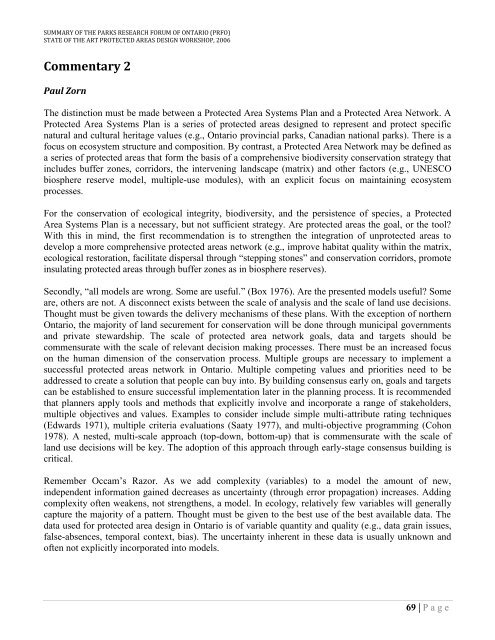Top-Down vs. Bottom Up: Working Towards Consensus ... - CASIOPA
Top-Down vs. Bottom Up: Working Towards Consensus ... - CASIOPA
Top-Down vs. Bottom Up: Working Towards Consensus ... - CASIOPA
- No tags were found...
You also want an ePaper? Increase the reach of your titles
YUMPU automatically turns print PDFs into web optimized ePapers that Google loves.
SUMMARY OF THE PARKS RESEARCH FORUM OF ONTARIO (PRFO)STATE OF THE ART PROTECTED AREAS DESIGN WORKSHOP, 2006Commentary 2Paul ZornThe distinction must be made between a Protected Area Systems Plan and a Protected Area Network. AProtected Area Systems Plan is a series of protected areas designed to represent and protect specificnatural and cultural heritage values (e.g., Ontario provincial parks, Canadian national parks). There is afocus on ecosystem structure and composition. By contrast, a Protected Area Network may be defined asa series of protected areas that form the basis of a comprehensive biodiversity conservation strategy thatincludes buffer zones, corridors, the intervening landscape (matrix) and other factors (e.g., UNESCObiosphere reserve model, multiple-use modules), with an explicit focus on maintaining ecosystemprocesses.For the conservation of ecological integrity, biodiversity, and the persistence of species, a ProtectedArea Systems Plan is a necessary, but not sufficient strategy. Are protected areas the goal, or the tool?With this in mind, the first recommendation is to strengthen the integration of unprotected areas todevelop a more comprehensive protected areas network (e.g., improve habitat quality within the matrix,ecological restoration, facilitate dispersal through “stepping stones” and conservation corridors, promoteinsulating protected areas through buffer zones as in biosphere reserves).Secondly, “all models are wrong. Some are useful.” (Box 1976). Are the presented models useful? Someare, others are not. A disconnect exists between the scale of analysis and the scale of land use decisions.Thought must be given towards the delivery mechanisms of these plans. With the exception of northernOntario, the majority of land securement for conservation will be done through municipal governmentsand private stewardship. The scale of protected area network goals, data and targets should becommensurate with the scale of relevant decision making processes. There must be an increased focuson the human dimension of the conservation process. Multiple groups are necessary to implement asuccessful protected areas network in Ontario. Multiple competing values and priorities need to beaddressed to create a solution that people can buy into. By building consensus early on, goals and targetscan be established to ensure successful implementation later in the planning process. It is recommendedthat planners apply tools and methods that explicitly involve and incorporate a range of stakeholders,multiple objectives and values. Examples to consider include simple multi-attribute rating techniques(Edwards 1971), multiple criteria evaluations (Saaty 1977), and multi-objective programming (Cohon1978). A nested, multi-scale approach (top-down, bottom-up) that is commensurate with the scale ofland use decisions will be key. The adoption of this approach through early-stage consensus building iscritical.Remember Occam‟s Razor. As we add complexity (variables) to a model the amount of new,independent information gained decreases as uncertainty (through error propagation) increases. Addingcomplexity often weakens, not strengthens, a model. In ecology, relatively few variables will generallycapture the majority of a pattern. Thought must be given to the best use of the best available data. Thedata used for protected area design in Ontario is of variable quantity and quality (e.g., data grain issues,false-absences, temporal context, bias). The uncertainty inherent in these data is usually unknown andoften not explicitly incorporated into models.69 | P a g e


